fxguide goes behind the scenes of the train crashes, train chases, scorpions and bridge explosions in Gore Verbinski’s The Lone Ranger. The film tells the story of Native American warrior Tonto (Johnny Depp) and the transformation of law-man John Reid (Armie Hammer) into the famous masked hero. We talk to VFX supes Tim Alexander from ILM, and Gary Brozenich from MPC about just some of Lone Ranger’s main effects sequences.
Crafting a train crash
Providing a source of conflict in the film is the advent of the railway across the United States. That means that steam locomotives feature heavily. In one sequence, Reid and Tonto find themselves atop a train engine steaming towards track workers – and – the end of the line. The loco smashes up the last pieces of track, with part of it flipping into the air and the rest sliding towards our heroes after they have made a dramatic dirt landing.
To accomplish that sequence, and many other visual effects shots in the film, ILM VFX supervisor Tim Alexander and director Verbinski discussed a ‘fifty per cent rule’ in which they would always try and get at least half the shot in camera. “We tried to base ourselves in live action and reality,” says Alexander. “Obviously we couldn’t do that for every shot, but it was the basis we came from.”
To that end, real train carriages and locomotives were filmed on a track constructed in New Mexico. Sometimes, the trains were were carried on a flatbed truck to facilitate more control and more takes. The real train was extensively photographed and LIDAR scanned, however, as part of building a CG counterpart. “We photographed it in daylight,” says Alexander, “and also in flat light, which was actually very difficult to do. We had to rent a gigantic circus tent so we could pull the train through it placed over the tracks.”
One shot in the crash sequence begins on the train tracks and moves all the way to Tonto and Reid’s faces, a distinctive shot that Verbinksi formulated in previs. ILM’s initial thought was that the practical portion of the shot could be achieved with a cable cam attached to the actual train. “The challenge was getting the camera to stop at the end of its run and not swing so that we could focus on the actors,” notes Alexander. “So what we did was shoot multiple passes that we could use for the background and for the train itself, and then we went and parked the train and recreated that same move up the side of the parked train with Johnny and Armie on it. That way the camera was much more controllable and we could actually get them into that final position.”
ILM’s layout department then massaged four or five different plates to match them together, using CG smoke and extra digital paint work to clean up areas such as the ground plane. “Then when they got into editorial they tacked another part onto the head of the shot that wasn’t intended to be in there at all!” says Alexander. “It starts with a guy waving a flag and Gore asked us to patch that in. We had to add one more plate to the head of the shot which means we had to do CG train transition to get to the b-side of the shot.”
Smoke formed a large part of the train crash and other sequences too. “John Frazier’s special effects team had smoker rigs run by diesel fuel that could produce black smoke and used these for elements,” says Alexander. “But getting the angle just right and with shots having strong perspective lines meant that was tough, so there was quite a bit of CG smoke additions. There was a point on the show where we had 17 effects artists just generating smoke.”
The train’s approach to the end of the line features a background plate of extras running away, filmed with an Edge Crane arm-mounted camera car. “We were able to drive down the track and get the camera into exactly the right position,” explains Alexander, “which we did by painting on the ground where we wanted the camera to be at different times, and then it was up to the vehicle and the camera operator to hit those marks.”
The crashing train was then a combination of a New Deal Studios miniature for dirt interaction and ILM’s CG model complete with simulated dirt, coal and rigid body train pieces. The actors, seen flying over camera, were digi-doubles crafted from texture and body photography and a Light Stage session for Hammer.
Spirit platform
After Reid survives an ambush, Tonto saves him but not before placing him atop a ‘spirt platform’ high above a canyon. MPC completed various backgrounds for the platform shots and others throughout the desert.
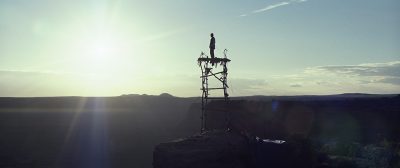
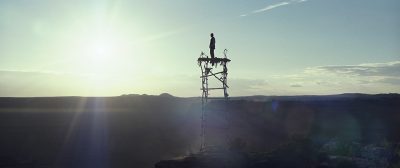
“The spirit platform was actually shot at Dead Horse Point in Utah and there was an incredible background already,” says MPC visual effects supervisor Gary Brozenich. “But we enhanced areas with some two and a half D work based on reference taken from aerial photos. We didn’t use LIDAR, but we did a Google Earth search and extracted geometry and a basic terrain from aerial footage we could get off of Google for the design process. We then used that to project photographs back on.”
Neck-deep in scorpions
A Comanche tribe captures Reid and Tonto who are buried up to their necks in the ground. Soon, several scorpions are climbing over the pair’s faces. MPC provided the digital crawlies and also delivered close-up shots of the horse Silver licking Reid’s face.
“We actually found a collector here in the UK who had a dried scorpion on display,” says Brozenich. “We sent a photographer to the guy’s house and he set up in the living room and we documented it starting there. On set there were live action scorpions. Due to the fact that they are so dangerous, there was one person allowed to handle them and they were not allowed anywhere near the principal actors who were bolted into the ground and buried up to their necks.”
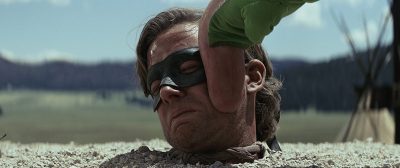
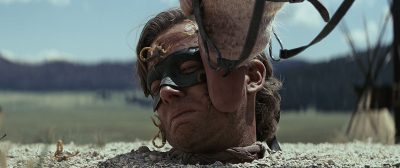
The CG scorpions were modeled in Maya, textured in ZBrush and then rendered in PRman with in-house shaders to provide a translucent look. “Scorpions are also quite furry and covered in a heavy layer of fuzz and we did that with Furtility our in-house grooming pipeline,” says Brozenich.
To deal with indentations made on the faces, MPC relied heavily on its matchmoving and tech-anim teams. “Tech-anim essentially do a cloth solve on the flesh to have it properly lock into place for indentations,” explains Brozenich. It really is an extremely difficult and important part of the process. Matchmoving is also crucial. We used a 3DEqualizer track and then also do some hand-tracking in Maya.”
Cavalry vs Comanche
In a fierce battle, the cavalry engage the Comanche with machine guns while the Comanche ride on horseback. MPC enhanced the sequence with additional digi-rides, horses and digital destruction from the gunfire.
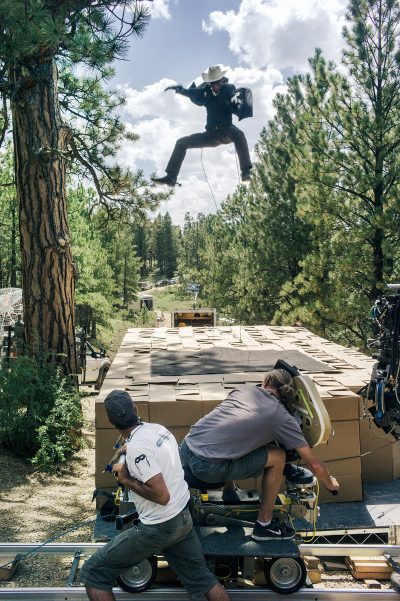 “The main bulk of the sequence was shot in New Mexico at Los Alamos on some ski slopes in the summertime,” states Brozenich. “They got in some native American bare-back riders and they worked with the stunt coordinators and trainers and the stuff they were doing was completely insane – incredibly fast down an extreme slope. Some were on jerk rigs and some doing falls themselves.”
“The main bulk of the sequence was shot in New Mexico at Los Alamos on some ski slopes in the summertime,” states Brozenich. “They got in some native American bare-back riders and they worked with the stunt coordinators and trainers and the stuff they were doing was completely insane – incredibly fast down an extreme slope. Some were on jerk rigs and some doing falls themselves.”
To fill out the riders, MPC engaged its in-house ALICE crowd system. “We can take the motion capture of a creature or a human and introduce a rigid body solver into it,” says Brozenich. “The agents will go rag-doll which means they just flop into death but we developed a way to dial in a certain amount of motion capture back into this rag-doll state so that it gives the appearance of having some life. We would have them get knocked off as if hit by gunfire, flop back and go into a rag-doll state.”
“We could then type in a percentage of motion capture to give them a flailing motion or running motion,” continues Brozenich. “For the horses, one of the most realistic looking effects was when we had a really severe galloping clip dialed back into a rag-doll horse. It gives the appearance of struggling or flailing.”
The sequence was filmed without any explosions occurring near the real horses, but the shots required trees to shatter and blow up from the machine gun fire. MPC used its finite element analysis tool Kali to destroy the trees, based on some destruction reference shot on set.
Cave escape
Tonto and Reid flee the cavalry and Comanche battle by narrowly escaping a cave nitroglycerin explosion – shots handled by MPC. “We started with concepts from designer Mark ‘Crash’ McCreery and then the rest was two and a half D projected matte paintings for the backgrounds,” says Brozenich. “There were two camera angles in the end, a wider and a tighter shot, so we had to model the whole thing and then projected DMP components on top. We did a significant CG explosion using Flowline.”
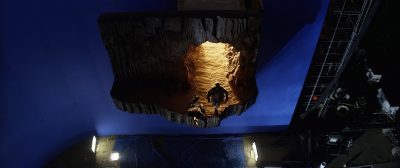
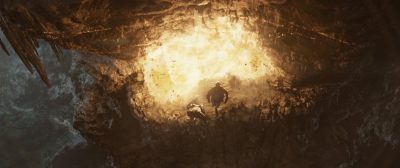
The train pursuit
In a rousing third act sequence with VFX by ILM, Tonto and Reid engage their enemies on two trains running side by side – and over and under each other – first through the desert and then into the mountains. Previs’d to match the familiar William Tell Overture of Lone Ranger fame, shots in the final piece were carefully timed. “We wanted to shoot as much as we could live action,” recalls Alexander, “but getting a train in the right place at the right time with just the right beat is just really impossible to shoot live action. We ended up building a lot of virtual environments for the sake of the story.”
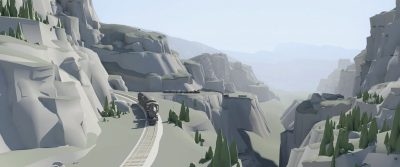
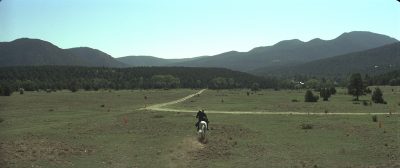
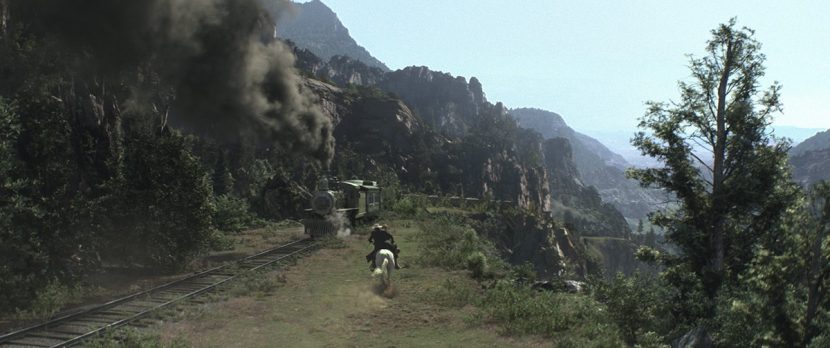
That also meant a combination of real plates, real trains, bluescreen actor plates filmed on static trains, live action backgrounds and digital environs. “We decided that getting the right depth of field, blur and lighting right from shot to shot that going all-CG actually gave us more realism than going with background plates,” says Alexander. “Our digi-matte team led by Dan Wheaton did a low-res slap together of the environment and blocked out each shot, and at that stage they could move mountains around and trees around. It wasn’t photoreal but it showed Gore where we would put stuff and we could be flexible to change things.”
“The old digi-matte approach might have been throwing tons of cards of trees out there,” adds Wheaton, “and it would be a photoreal look but a two and a half D approach. But because of the camera moves we had to go significantly higher in 3D, although we would still use cards for the distant mountains. When trees were so close to camera, you had to have wind and what not affecting them.”
The environment pipeline relied on a V-Ray and 3ds Max workflow. “Because V-Ray could crush the renders,” says Wheaton, “it was super-fast handling even complex things like trees, we were able to get an early blocking take for Gore. It was almost 70% of the look. We used SpeedTree to create all the different trees and scrub and vegetation.”
Blowing up the bridge
Earlier, Reid and Tonto steal nitroglycerin and use it to destroy a railroad trestle bridge (the effect is that railway tycoon Latham Cole plunges off the severed bridge after the lengthy pursuit).
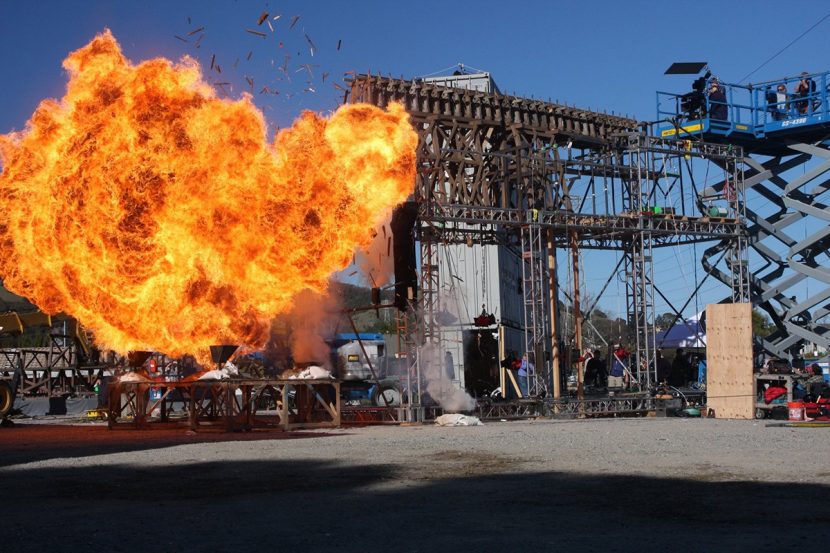
The bridge explosion was achieve with a combination of live action, miniature work and digital simulations from ILM. “I knew we needed splintering boards and water interaction and very close-up flames so went with a miniature for three of the five shots,” says Alexander. “So any time you see the bridge wide, it’s a CG bridge and the three close in shots were done as a miniature by 32TEN Studios.” 32TEN build a 1/5th scale model, the largest being 33 feet long by 25 feet tall. It was filmed on high speed VistaVision in the studio’s backlot in a 50 x 50 water tank against an 80 x 32 foot greenscreen.
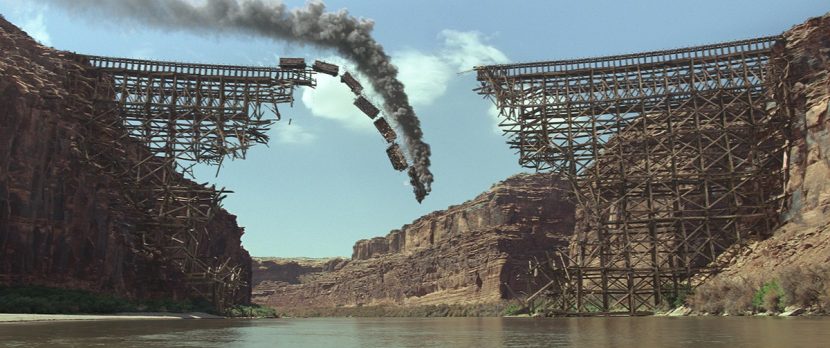
All images and clips copyright © 2013 Walt Disney Pictures.

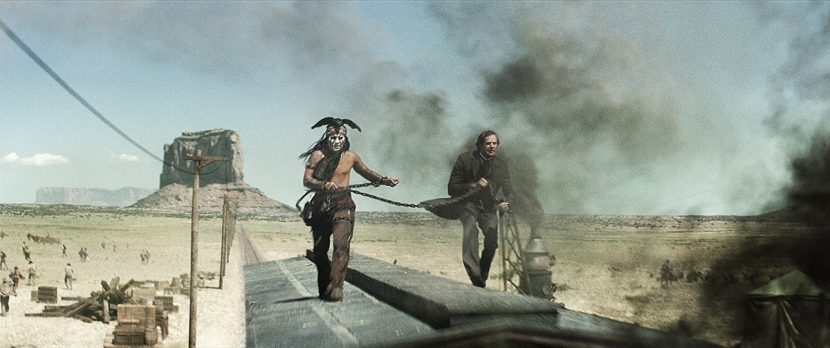
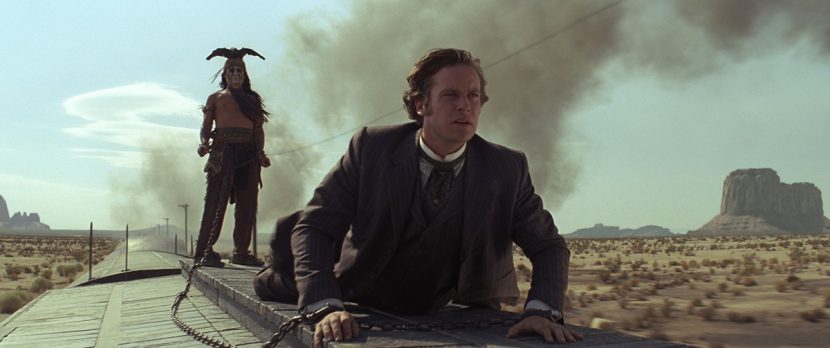
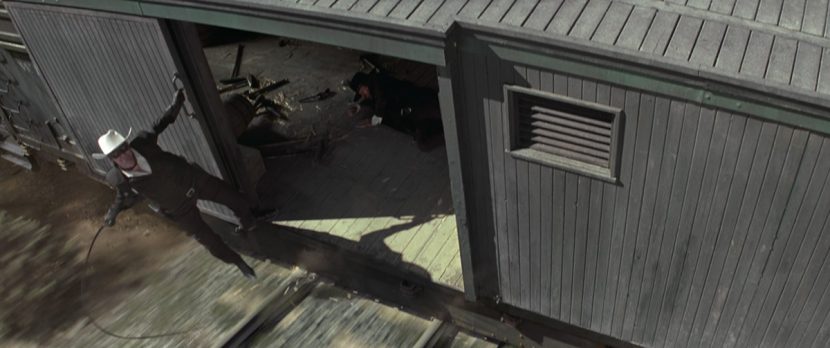
Pingback: VFX Breakdown: The Lone Ranger (O Cavaleiro Solitário) | Dicas e Tutoriais de After Effects